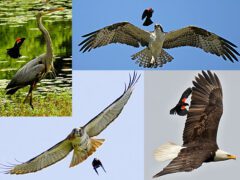Mexican Whip-poor-will Similar Species Comparison
Main SpeciesMexican Whip-poor-will
Highly camouflaged, with an intricate mix of black, brown, gray, buffy, and rufous feathers. Note the faint buffy-white collar contrasting with black throat and breast feathers. Females show limited buffy tips to the outer tail feathers.
© Mauricio López / Macaulay LibraryNuevo León, August 19, 2018Nightjar coloration can vary based on age, individual variation, and lighting conditions.
© Daniel Garza Tobón / Macaulay LibraryChiapas, May 16, 2017Adult males have bold white tips on their outer tail feathers.
© Moises Rodriguez / Macaulay LibrarySololá, October 06, 2015Highly camouflaged, with an intricate mix of black, brown, gray, buffy, and rufous feathers. Note the thin buffy-white collar contrasting with black throat and breast feathers. Adult males have extensive white in their outer tail feathers.
© Evan Buechley / Macaulay LibraryNew Mexico, June 12, 2020Mexican Whip-poor-wills have small bills bordered by long rictal bristles (modified, whisker-like feathers).
© Shailesh Pinto / Macaulay LibraryArizona, August 27, 2020Similar SpeciesEastern Whip-poor-will
Eastern Whip-poor-wills are extremely similar to Mexican Whip-poor-wills and are best identified by song. Their breeding ranges do not overlap, but in areas where they both overwinter in Mexico and Central America, silent birds may be best left as Eastern/Mexican Whip-poor-will.
© Ryan Zucker / Macaulay LibraryNew York, June 14, 2020Similar SpeciesBuff-collared Nightjar
Buff-collared Nightjars are paler above than Mexican Whip-poor-wills, with a thicker, more prominent buff collar around the back of the head. Buff-collared Nightjars occur in dry desert washes (rather than forest) and are most easily identified by the male's distinctive “cookacheea” or “préstame-tu-cuchillo” song.
© Hannes Leonard / Macaulay LibraryOaxaca, January 01, 2023Similar SpeciesCommon Poorwill
Common Poorwills are smaller, grayer, and shorter-tailed than Mexican Whip-poor-wills. Common Poorwills occur in dry, open habitats (rather than forest) where males sing their repeated “poor-willip” songs.
© Sharif Uddin / Macaulay LibraryCalifornia, May 14, 2023Similar SpeciesCommon Pauraque
Common Pauraques are longer-tailed than Mexican Whip-poor-wills and have a prominent white (males) or buffy (females) wing band visible in flight. Male pauraques also have extensive white in the tail (partially visible here), much more than Mexican Whip-poor-wills.
© Adam Jackson / Macaulay LibraryQuintana Roo, May 10, 2023Similar SpeciesLesser Nighthawk
Lesser Nighthawks have longer wings than Mexican Whip-poor-wills, a prominent white throat collar, and limited or no rictal bristles (“whiskers”) around the bill.
© John van Dort / Macaulay LibraryValle, May 27, 2013Similar SpeciesLesser Nighthawk
Lesser Nighthawks occur in open habitats where they are much more likely to be seen during the daytime and/or in flight than Mexican Whip-poor-wills. In flight, nighthawks have more pointed wings than whip-poor-wills, with a white (males) or buffy (females) wing band.
© Sharif Uddin / Macaulay LibraryCalifornia, September 15, 2019Similar SpeciesCommon Nighthawk
Common Nighthawks have longer wings than Mexican Whip-poor-wills, a prominent white throat collar, and limited or no rictal bristles (“whiskers”) around the bill.
© Matt Davis / Macaulay LibraryNevada, August 10, 2019Similar SpeciesCommon Nighthawk
Common Nighthawks occur in open habitats where they are much more likely to be seen during the daytime and/or in flight than Mexican Whip-poor-wills. In flight, nighthawks have more pointed wings than whip-poor-wills, with a striking white wing band.
© Phil Chaon / Macaulay LibraryNew Mexico, May 27, 2021Compare with Similar Species
Click on an image to compare
Species in This Family
Nightjars and Allies(Order: Caprimulgiformes, Family: Caprimulgidae)
More to Read
Don't miss a thing! Join our email list
The Cornell Lab will send you updates about birds,
birding, and opportunities to help bird conservation.














